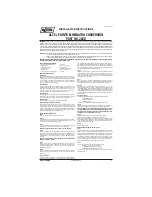
▷
For tires with special approval: the system
was unable to complete the reset. Perform a
system reset again.
Malfunction: have the system checked.
Declaration according to NHTSA/
FMVSS 138 Tire Pressure
Monitoring System
Each tire, including the spare (if provided) should
be checked monthly when cold and inflated to
the inflation pressure recommended by the vehi‐
cle manufacturer on the vehicle placard or tire in‐
flation pressure label. (If your vehicle has tires of
a different size than the size indicated on the ve‐
hicle placard or tire inflation pressure label, you
should determine the proper tire inflation pres‐
sure for those tires.) As an added safety feature,
your vehicle has been equipped with a tire pres‐
sure monitoring system (TPMS) that illuminates
a low tire pressure telltale when one or more of
your tires is significantly under-inflated. Accord‐
ingly, when the low tire pressure telltale illumi‐
nates, you should stop and check your tires as
soon as possible, and inflate them to the proper
pressure. Driving on a significantly under-inflated
tire causes the tire to overheat and can lead to
tire failure. Under-inflation also reduces fuel effi‐
ciency and tire tread life, and may affect the vehi‐
cle's handling and stopping ability. Please note
that the TPMS is not a substitute for proper tire
maintenance, and it is the driver's responsibility
to maintain correct tire pressure, even if under-
inflation has not reached the level to trigger illu‐
mination of the TPMS low tire pressure telltale.
Your vehicle has also been equipped with a
TPMS malfunction indicator to indicate when the
system is not operating properly. The TPMS
malfunction indicator is combined with the low
tire pressure telltale. When the system detects a
malfunction, the telltale will flash for approxi‐
mately one minute and then remain continuously
illuminated. This sequence will continue upon
subsequent vehicle start-ups as long as the mal‐
function exists. When the malfunction indicator is
illuminated, the system may not be able to de‐
tect or signal low tire pressure as intended.
TPMS malfunctions may occur for a variety of
reasons, including the installation of replacement
or alternate tires or wheels on the vehicle that
prevent the TPMS from functioning properly. Al‐
ways check the TPMS malfunction telltale after
replacing one or more tires or wheels on your ve‐
hicle to ensure that the replacement or alternate
tires and wheels allow the TPMS to continue to
function properly.
Flat Tire Monitor FTM
Concept
The system detects tire inflation pressure loss
on the basis of rotation speed differences be‐
tween the individual wheels while driving.
In the event of a tire inflation pressure loss, the
diameter and therefore the rotational speed of
the corresponding wheel changes. The differ‐
ence will be detected and reported as a flat tire.
The system does not measure the actual infla‐
tion pressure in the tires.
Functional requirements
The following conditions must be met for the
system; otherwise, reliable flagging of a loss of
tire inflation pressure is not assured:
▷
After a tire or wheel replacement, an initializa‐
tion was performed with the correct tire infla‐
tion pressure.
▷
After the tire pressure was adjusted to a new
value, an initialization was performed.
Status display
The current status of the Flat Tire Monitor FTM
can be displayed, for instance whether the FTM
is active.
1.
"CAR"
2.
"Vehicle status"
3.
"Flat Tire Monitor"
The status is displayed.
Seite 344
MOBILITY
Wheels and tires
344
Online Edition for Part no. 01405A11338 - VI/20
Содержание 5 series sedan
Страница 2: ...Online Edition for Part no 01405A11338 VI 20...
Страница 317: ...Saving fuel DRIVING TIPS 317 Online Edition for Part no 01405A11338 VI 20...
Страница 399: ...BL5A1133800B 01405A11338 ue...
Страница 400: ......
Страница 401: ...California Proposition 65 Warning For vehicles sold in California Online Edition for Part no 01405A11338 VI 20...
















































